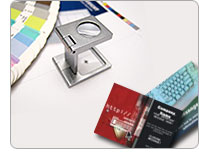- Products
-
Design Templates
- Featured Design Galleries
- More Galleries
- Services & Resources
- Free Sample Kit
- Deals
 You've got an incredible offer, the perfectly primed mailing list, and the design can't be beat - unless you print on the wrong paper. When it comes to direct-marketing printing, the wrong paper can make an outstanding design sputter while the right paper can make even a lackluster design brim with brilliance. So how do you decide which paper to print on?
You've got an incredible offer, the perfectly primed mailing list, and the design can't be beat - unless you print on the wrong paper. When it comes to direct-marketing printing, the wrong paper can make an outstanding design sputter while the right paper can make even a lackluster design brim with brilliance. So how do you decide which paper to print on?
Audience first
Ask any printing company which paper stock to print on, and they'll most likely offer you something that looks great and that fits your budget. For some printers, it's a matter of taste or profit margin, but you should only be concerned with your audience's expectations and not your printer's. If your audience is expecting subdued prestige, such as for a high-concept art gallery, then thick matte paper would do the trick. If your audience is expecting refined luxury, such as for a jeweler, then a thick glossy paper would be in order. Sometimes your audience expects you to look cheap. A brochure supporting a school levy in a budget-strapped community might be printed on thin paper to lend the impression that the levy money will be spent in frugal fashion. A thick, aqueous coated brochure paper stock might be deemed a waste of money by taxpayers. Audience perception is crucial, so find out what your audience expects first to determine the perfect type of paper for your printing projects.
Medium second
 What you're printing is nearly as important as who you're sending it to. Printing thick door hangers is good, but if your brochures are so thick they crack rather than fold you might be overdoing it. That being said, straying from the norm will help you stand out from your competitors. A brochure printed oversized at 11-inch by 17-inch and on an extra-thick 100-pound gloss cover paper stock will be noticed in your prospects' mailboxes much quicker than a standard 8.5-inch by 11-inch brochure printed on 100-pound gloss text.
What you're printing is nearly as important as who you're sending it to. Printing thick door hangers is good, but if your brochures are so thick they crack rather than fold you might be overdoing it. That being said, straying from the norm will help you stand out from your competitors. A brochure printed oversized at 11-inch by 17-inch and on an extra-thick 100-pound gloss cover paper stock will be noticed in your prospects' mailboxes much quicker than a standard 8.5-inch by 11-inch brochure printed on 100-pound gloss text.
Price last
Printing marketing materials is an investment, not an expense, and so you should consider your price last. Experiment with different types of paper stocks in your direct-mail campaigns to see which yields the highest return on investment. You should do this for the same campaign against different sections of your target audience to get accurate results. You might discover that while oversized, thick brochures cost more to print than standard brochures, they yield a half-percent higher Return on investment and therefore an increased profit margin. Mix it up and measure results to fine-tune your marketing campaign. Your choice of paper stocks not only influences your profit, it can make or break your marketing campaign. Choose the best paper stocks for your audience from a quality online printing company for the best results.